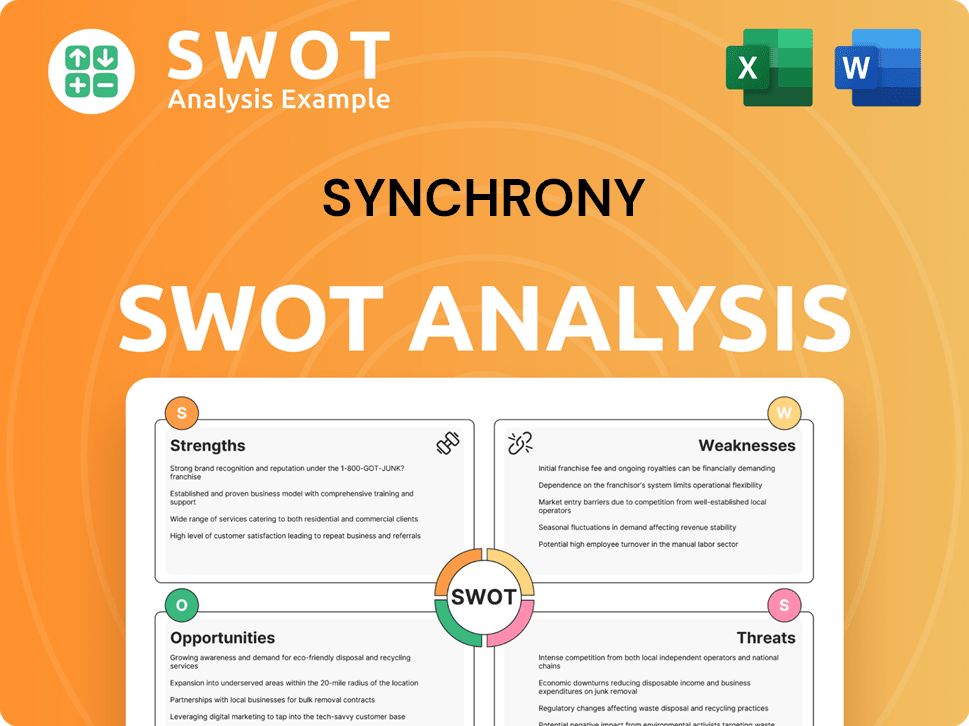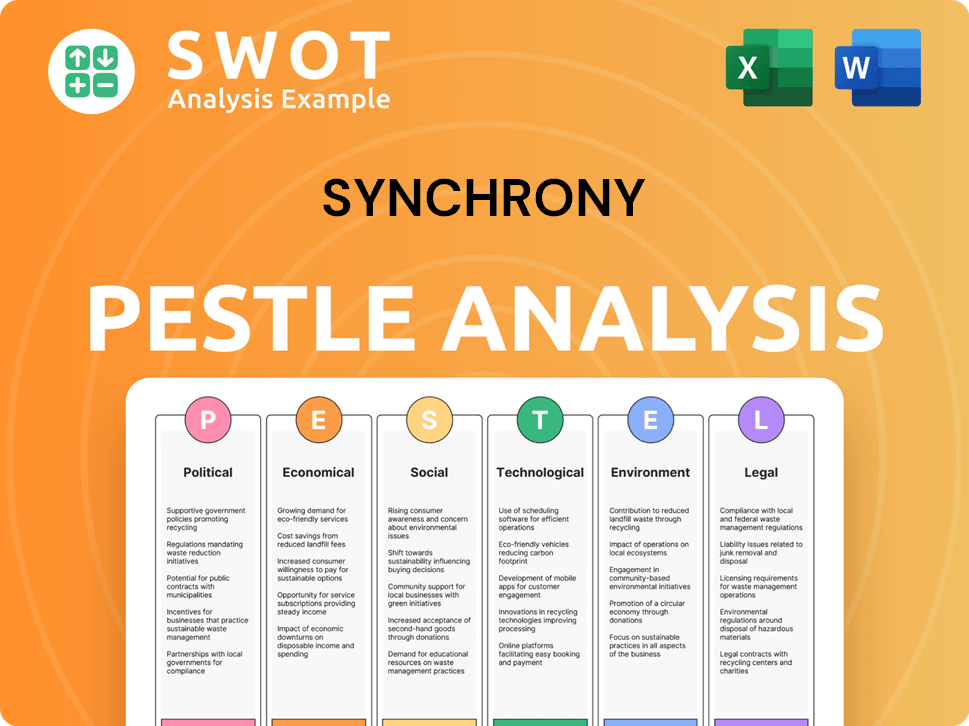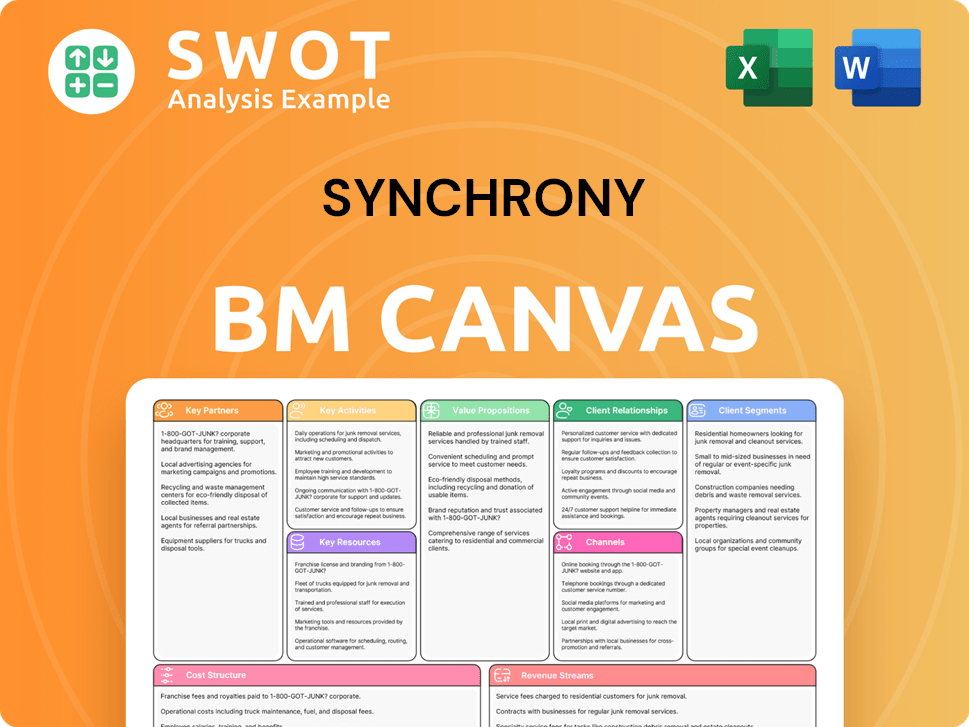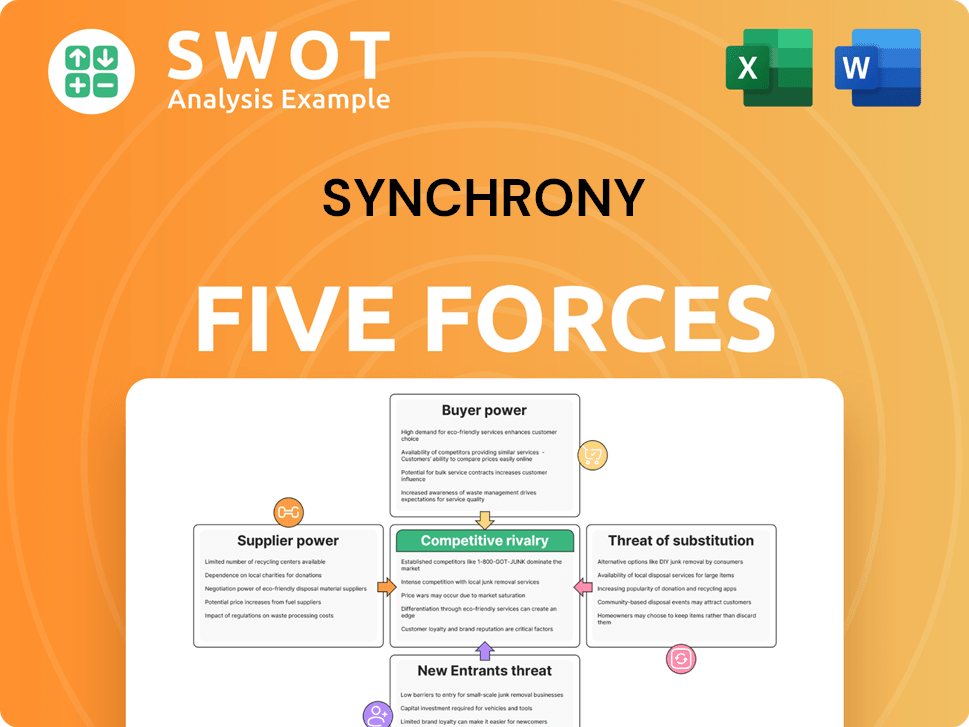Synchrony Bundle
Can Synchrony Company Continue Its Ascent in the Financial Services Sector?
Synchrony Financial, a leading player in consumer financial services, is navigating a rapidly changing landscape. Understanding the Synchrony SWOT Analysis is crucial to grasp how this credit card company plans to thrive. This exploration dives into Synchrony's growth strategy and future prospects, offering a comprehensive market analysis.

From its roots in 1932, Synchrony has evolved into a financial powerhouse, and its success hinges on strategic initiatives. This analysis will examine Synchrony's expansion plans, competitive advantages, and financial performance. We'll also explore Synchrony's digital transformation strategy and its impact on the financial industry, providing insights into potential investment opportunities and its long-term growth outlook.
How Is Synchrony Expanding Its Reach?
The expansion initiatives of the company are primarily focused on deepening existing partnerships, forging new alliances, and diversifying its product offerings. This strategy aims to reach new customer segments and boost revenue streams. A key area of focus is the healthcare financing sector, a market with significant growth potential, as highlighted in recent financial reports and market analysis.
A core component of the company's expansion strategy involves enhancing its CareCredit platform. This platform provides financing for health and wellness needs, including dental, veterinary, and cosmetic procedures. This expansion is driven by the increasing consumer demand for flexible payment options in healthcare. The company is also exploring new product categories and digital solutions to cater to evolving consumer preferences, which is part of its digital transformation strategy.
Furthermore, the company is focused on growing its direct-to-consumer offerings, such as its Synchrony Bank savings products. This contributes to a diversified funding base for its lending activities, which is crucial for its long-term growth outlook. While specific international expansion plans are less prominent, the focus remains on leveraging its strong domestic market position and exploring opportunities within existing partnerships to expand its reach. For more insights, you can explore the Target Market of Synchrony.
The company is actively enhancing its CareCredit platform to meet the growing demand for flexible payment options in healthcare. This includes dental, veterinary, and cosmetic procedures. This strategic move aligns with the company's goal to partner with a wider array of healthcare providers and capture a larger share of the market.
The company is developing enhanced digital payment options and integrating its financing solutions more seamlessly into online and mobile purchasing experiences. Synchrony aims to capture a larger share of e-commerce transactions by offering embedded financing at the point of sale. This approach is part of its digital transformation strategy, enhancing customer acquisition strategies.
The company is focused on growing its direct-to-consumer offerings, such as its Synchrony Bank savings products. This diversification helps in building a robust funding base. This strategy supports its overall financial performance and contributes to its long-term growth outlook, providing a competitive advantage.
The company emphasizes deepening existing partnerships and forging new alliances to expand its reach. While specific international expansion plans are less prominent, the focus remains on leveraging its strong domestic market position. This approach is key to its market share analysis and revenue growth drivers.
The company's financial performance in Q4 2023 showed positive growth. It is a credit card company that is focused on financial services.
- Average active accounts increased by 5% year-over-year.
- Average loan receivables grew by 12% year-over-year.
- These figures indicate successful organic growth within its existing framework, highlighting its competitive advantages.
- The company's strategic initiatives are driving its expansion plans.
Synchrony SWOT Analysis
- Complete SWOT Breakdown
- Fully Customizable
- Editable in Excel & Word
- Professional Formatting
- Investor-Ready Format

How Does Synchrony Invest in Innovation?
The innovation and technology strategy of the Synchrony Company is crucial for its ongoing expansion. This strategy focuses on digital transformation, data analytics, and the integration of advanced technologies. The company invests significantly in its internal development to improve its platforms and create new digital tools, which is key to its Synchrony Growth Strategy.
A central element of this strategy involves using artificial intelligence (AI) and machine learning (ML). These technologies are used to enhance credit decision-making, personalize customer experiences, and optimize marketing strategies. For example, AI helps analyze large datasets to identify creditworthy customers more accurately and efficiently, leading to better risk management and higher approval rates. This approach supports Synchrony's Future Prospects by improving operational efficiency and customer satisfaction.
Furthermore, Synchrony is dedicated to digital transformation, aiming to offer seamless digital experiences for both partners and consumers. This includes investments in mobile applications, online account management tools, and digital onboarding processes. The company's focus on open banking and APIs allows for greater integration with partner systems, streamlining the financing experience at the point of sale. This commitment to technological advancement is essential for maintaining a competitive edge in the financial services industry.
The company is heavily investing in digital transformation to improve customer experience. This includes enhancements to mobile apps and online account management tools.
AI and ML are used to improve credit decision-making and personalize customer experiences. These technologies help in identifying creditworthy customers more accurately.
Open banking initiatives and APIs facilitate greater integration with partner systems. This leads to a streamlined financing experience at the point of sale.
Significant investments are made in in-house development capabilities. This supports the creation of new digital tools and platform enhancements.
In 2023, there was a reported increase in digital account originations. This highlights the success of their digital initiatives.
The company is focused on expanding its digital product offerings. This is part of its strategy to meet evolving customer needs.
The company's technological strategies are designed to drive growth and enhance customer experience. These initiatives support the company's strategic goals in the Financial Services sector.
- Data Analytics: Utilizing data analytics to gain insights into customer behavior and market trends.
- AI and ML Integration: Implementing AI and ML to automate processes and personalize customer interactions.
- Digital Platforms: Developing and enhancing digital platforms to provide seamless and user-friendly experiences.
- Partnerships: Collaborating with partners to integrate financial solutions into various platforms.
For further insights into the company's structure and performance, consider reading about Owners & Shareholders of Synchrony. This focus on innovation and technology positions the company favorably in the competitive landscape of the Credit Card Company sector, driving its Synchrony's Expansion Plans and contributing to its overall success through effective Market Analysis and strategic execution.
Synchrony PESTLE Analysis
- Covers All 6 PESTLE Categories
- No Research Needed – Save Hours of Work
- Built by Experts, Trusted by Consultants
- Instant Download, Ready to Use
- 100% Editable, Fully Customizable

What Is Synchrony’s Growth Forecast?
The financial outlook for Synchrony reflects a strategic focus on sustainable growth and disciplined credit management. The company's performance in 2023 demonstrates its resilience and strong financial position, even amidst economic fluctuations. Understanding the Competitors Landscape of Synchrony helps to analyze its market position and future prospects.
Synchrony's financial strategy includes diversified revenue streams and a commitment to shareholder value. This is evident in its consistent dividend payouts and share repurchase programs. The company's ability to maintain healthy profit margins and a strong capital position supports continued investment in technology and strategic acquisitions, which are key components of its Synchrony Growth Strategy.
For the fourth quarter of 2023, Synchrony reported net earnings of $475 million, with diluted earnings per share at $1.09. For the full year 2023, net earnings were $2.5 billion, and diluted earnings per share were $5.39. These figures highlight the company's robust financial performance and its ability to generate consistent profits. Synchrony's Future Prospects are tied to these strong financial results.
Synchrony anticipates continued growth in loan receivables and interest income. This growth is driven by expansion in healthcare and digital channels. The company's strategic initiatives are designed to capitalize on these opportunities.
Synchrony's funding strategy includes deposits from Synchrony Bank and securitized debt. This mix provides a stable and diversified funding base. This supports its lending activities and contributes to its financial stability.
The company's shareholder-friendly financial strategy includes consistent dividend payouts and share repurchases. These actions aim to return value to investors while reinvesting for future growth. This approach supports Synchrony's long-term growth outlook.
Net interest income for Q4 2023 was $4.2 billion, up from $4.1 billion in the prior year period. This increase highlights the robust financial performance of the company. This growth is a key indicator of Synchrony's financial health.
Synchrony's financial performance is supported by several key metrics that demonstrate its stability and growth potential. These metrics are crucial for understanding Synchrony's market share analysis and its position within the Financial Services industry.
- Net Earnings: $2.5 billion for the full year 2023.
- Diluted Earnings Per Share: $5.39 for the full year 2023.
- Net Interest Income (Q4 2023): $4.2 billion.
- Loan Receivables: Expected to grow due to expansion initiatives.
Synchrony Business Model Canvas
- Complete 9-Block Business Model Canvas
- Effortlessly Communicate Your Business Strategy
- Investor-Ready BMC Format
- 100% Editable and Customizable
- Clear and Structured Layout

What Risks Could Slow Synchrony’s Growth?
The Synchrony Company's growth strategy faces several potential risks and obstacles. The financial services industry is highly competitive, with established players and emerging fintech companies vying for market share. Furthermore, regulatory changes and technological disruptions constantly reshape the landscape, demanding continuous adaptation and investment.
Market competition, regulatory changes, and technological advancements pose significant challenges. Supply chain vulnerabilities and internal resource constraints add further complexities. The company must navigate these challenges while continuously innovating and managing risks effectively.
Synchrony addresses these challenges through a comprehensive risk management framework. This includes robust credit underwriting, diversification of its partner portfolio, and ongoing monitoring of the regulatory landscape. Vigilance in managing credit risk is crucial, as indicated by recent financial data.
The financial services sector is intensely competitive, with numerous players vying for market share. This includes established financial institutions, fintech startups, and other credit card companies. Competitive pressures can impact pricing, partnerships, and profitability, affecting Synchrony's ability to grow.
The financial industry is heavily regulated, and changes in consumer protection laws, interest rate policies, or data privacy regulations can significantly impact operations. Adapting to new regulations requires substantial operational adjustments and can affect Synchrony's business model.
Supply chain disruptions, particularly for retail partners, can indirectly affect Synchrony's business. These disruptions can impact consumer spending and the demand for financing, thereby affecting Synchrony's revenue and growth.
Rapid technological change requires continuous investment and adaptation to new technologies to remain competitive. Cybersecurity threats and data breaches also pose significant risks, demanding robust security measures and ongoing investment in technology.
Attracting and retaining top talent in a competitive labor market can hinder growth initiatives. Internal resource constraints, such as limitations in skilled personnel, can impact the execution of Synchrony's strategic plans and overall performance.
Maintaining credit quality is crucial for financial stability. For Q4 2023, net charge-offs as a percentage of average loan receivables were at 5.51%, an increase from 4.80% the prior year. This highlights the importance of vigilant credit risk management.
Synchrony employs a comprehensive risk management framework. This includes robust credit underwriting standards, diversification of its partner portfolio, and continuous monitoring of the regulatory environment. The company also uses scenario analysis to prepare for various market conditions.
These risks can affect Synchrony's financial performance, including revenue growth, profitability, and market share. Managing these risks effectively is critical for achieving its long-term growth outlook. For more detailed insights into the company, explore a comprehensive market analysis.
Synchrony Porter's Five Forces Analysis
- Covers All 5 Competitive Forces in Detail
- Structured for Consultants, Students, and Founders
- 100% Editable in Microsoft Word & Excel
- Instant Digital Download – Use Immediately
- Compatible with Mac & PC – Fully Unlocked

Related Blogs
- What are Mission Vision & Core Values of Synchrony Company?
- What is Competitive Landscape of Synchrony Company?
- How Does Synchrony Company Work?
- What is Sales and Marketing Strategy of Synchrony Company?
- What is Brief History of Synchrony Company?
- Who Owns Synchrony Company?
- What is Customer Demographics and Target Market of Synchrony Company?
Disclaimer
All information, articles, and product details provided on this website are for general informational and educational purposes only. We do not claim any ownership over, nor do we intend to infringe upon, any trademarks, copyrights, logos, brand names, or other intellectual property mentioned or depicted on this site. Such intellectual property remains the property of its respective owners, and any references here are made solely for identification or informational purposes, without implying any affiliation, endorsement, or partnership.
We make no representations or warranties, express or implied, regarding the accuracy, completeness, or suitability of any content or products presented. Nothing on this website should be construed as legal, tax, investment, financial, medical, or other professional advice. In addition, no part of this site—including articles or product references—constitutes a solicitation, recommendation, endorsement, advertisement, or offer to buy or sell any securities, franchises, or other financial instruments, particularly in jurisdictions where such activity would be unlawful.
All content is of a general nature and may not address the specific circumstances of any individual or entity. It is not a substitute for professional advice or services. Any actions you take based on the information provided here are strictly at your own risk. You accept full responsibility for any decisions or outcomes arising from your use of this website and agree to release us from any liability in connection with your use of, or reliance upon, the content or products found herein.